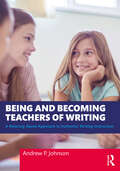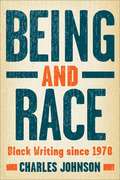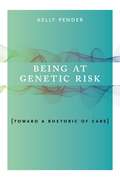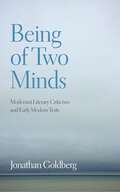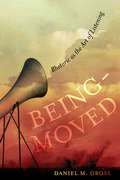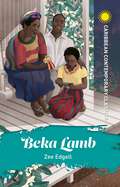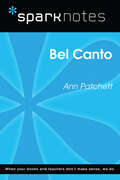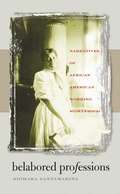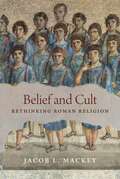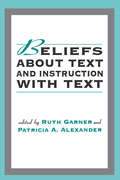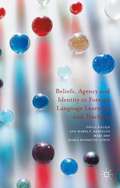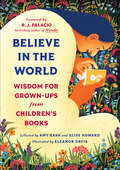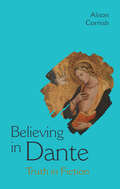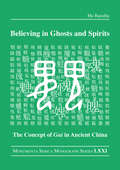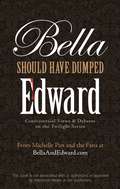- Table View
- List View
Being a Writer™, Grade 1, Reproducibles
by Center for the Collaborative ClassroomNIMAC-sourced textbook
Being a Writer™, Grade 2, Reproducibles
by Center for the Collaborative ClassroomNIMAC-sourced textbook
Being a Writer™, Grade 3, Reproducibles
by Center for the Collaborative ClassroomNIMAC-sourced textbook
Being a Writer™, Grade 4, Reproducibles
by Center for the Collaborative ClassroomNIMAC-sourced textbook
Being a Writer™, Grade 5, Reproducibles
by Center for the Collaborative ClassroomNIMAC-sourced textbook
Being a Writer™, Grade K, Reproducibles
by Center for the Collaborative ClassroomNIMAC-sourced textbook
Being a Writer™, [Grade 1], Student Skill Practice Book
by Developmental Studies Center StaffNIMAC-sourced textbook
Being and Becoming Teachers of Writing: A Meaning-Based Approach to Authentic Writing Instruction
by Andrew P. JohnsonThis engaging, inviting textbook from a renowned expert in writing education provides all the knowledge, pedagogical strategies, and tools needed to enable any teacher to be an effective teacher of writing.Using the five-step writing process as a foundation, the text describes how to teach the necessary skills related to grammar, spelling, punctuation, and other writing mechanics, and addresses all major genres and stages of writing. Written in an authentic voice that exemplifies good writing, Johnson presents a variety of pragmatic, research-based strategies that support students’ writing development and encourage teachers to apply their own creativity and intelligence in the classroom.This is an essential text for courses in writing instruction, literacy methods, and teaching English Language Arts (ELA).
Being and Race: Black Writing Since 1970
by Charles JohnsonFor the first time in ebook, renowned scholar Charles Johnson's exploration of contemporary black literature and the meaning of the black experience as expressed through the writers Richard Wright, Jean Toomer, David Bradley, and others. Charles Johnson approaches contemporary black literature through the lens of phenomenology. Drawing on such philosophers as Heidegger, Husserl, Satre, and Dufrenne, Johnson addresses the esthetic and epistemological questions surrounding the black experience as expressed by African American authors. In exploring the works of Wright, Toomer, Bradley, and many more, Being & Race enlarges our vision of what fiction's purpose is and how it arises from our common experiences.
Being at Genetic Risk: Toward a Rhetoric of Care (RSA Series in Transdisciplinary Rhetoric #10)
by Kelly PenderRhetorics of choice have dominated the biosocial discourses surrounding BRCA risk for decades, telling women at genetic risk for breast and ovarian cancers that they are free to choose how (and whether) to deal with their risk. Critics argue that women at genetic risk are, in fact, not free to choose but rather are forced to make particular choices. In Being at Genetic Risk, Kelly Pender argues for a change in the conversation around genetic risk that focuses less on choice and more on care.Being at Genetic Risk offers a new set of conceptual starting points for understanding what is at stake with a BRCA diagnosis and what the focus on choice obstructs from view. Through a praxiographic reading of the medical practices associated with BRCA risk, Pender’s analysis shows that genetic risk is not just something BRCA+ women know, but also something that they do. It is through this doing that genetic cancer risk becomes a reality in their lives, one that we can explain but not one that we can explain away.Well researched and thoughtfully argued, Being at Genetic Risk will be welcomed by scholars of rhetoric and communication, particularly those who work in the rhetoric of science, technology, and medicine, as well as scholars in allied fields who study the social, ethical, and political implications of genetic medicine. Pender’s insight will also be of interest to organizations that advocate for those at genetic risk of breast and ovarian cancers.
Being at Genetic Risk: Toward a Rhetoric of Care (RSA Series in Transdisciplinary Rhetoric)
by Kelly PenderRhetorics of choice have dominated the biosocial discourses surrounding BRCA risk for decades, telling women at genetic risk for breast and ovarian cancers that they are free to choose how (and whether) to deal with their risk. Critics argue that women at genetic risk are, in fact, not free to choose but rather are forced to make particular choices. In Being at Genetic Risk, Kelly Pender argues for a change in the conversation around genetic risk that focuses less on choice and more on care.Being at Genetic Risk offers a new set of conceptual starting points for understanding what is at stake with a BRCA diagnosis and what the focus on choice obstructs from view. Through a praxiographic reading of the medical practices associated with BRCA risk, Pender’s analysis shows that genetic risk is not just something BRCA+ women know, but also something that they do. It is through this doing that genetic cancer risk becomes a reality in their lives, one that we can explain but not one that we can explain away.Well researched and thoughtfully argued, Being at Genetic Risk will be welcomed by scholars of rhetoric and communication, particularly those who work in the rhetoric of science, technology, and medicine, as well as scholars in allied fields who study the social, ethical, and political implications of genetic medicine. Pender’s insight will also be of interest to organizations that advocate for those at genetic risk of breast and ovarian cancers.
Being of Two Minds: Modernist Literary Criticism and Early Modern Texts
by Jonathan GoldbergBeing of Two Minds examines the place that early modern literature held in Modernist literary criticism. For T. S. Eliot, Virginia Woolf, and William Empson, the early modern period helps model a literary future. At stake in their engagements across time were ontological questions about literature and its ability to mediate between the one and the many, the particular and the general, life and death, the past and the present. If reading and writing literature enables the mind to be in two places at once, creative experience serves as a way to participate in an expanded field of consciousness alongside mortality.Goldberg reads the readings that these modernists performed on texts that Eliot claimed for the canon like the metaphysical poets and Jacobean dramatists, but also Shakespeare, Milton, Montaigne, and Margaret Cavendish. Ontological concerns are reflected in Eliot’s engagement with Aristotle’s theory of the soul and Empson’s Buddhism. These arguments about being affect minds and bodies and call into question sexual normativity: Eliot glances at a sodomitical male-male mode of literary transmission; Woolf produces a Judith Shakespeare to model androgynous being; Empson refuses to distinguish activity from passivity to rewrite gender difference.The work of one of our leading literary and cultural critics, Being of Two Minds spans centuries to show how the most compelling and surprising ideas about mind, experience, and existence not only move between early modernity, high modernism, and our own moment, but are also constituted through that very movement between times and minds.
Being with the Dead: Burial, Ancestral Politics, and the Roots of Historical Consciousness (Cultural Memory in the Present)
by Hans RuinPhilosophy, Socrates declared, is the art of dying. This book underscores that it is also the art of learning to live and share the earth with those who have come before us. Burial, with its surrounding rituals, is the most ancient documented cultural-symbolic practice: all humans have developed techniques of caring for and communicating with the dead. The premise of Being with the Dead is that we can explore our lives with the dead as a cross-cultural existential a priori out of which the basic forms of historical consciousness emerge. Care for the dead is not just about the symbolic handling of mortal remains; it also points to a necropolitics, the social bond between the dead and living that holds societies together—a shared space or polis where the dead are maintained among the living. Moving from mortuary rituals to literary representations, from the problem of ancestrality to technologies of survival and intergenerational communication, Hans Ruin explores the epistemological, ethical, and ontological dimensions of what it means to be with the dead. His phenomenological approach to key sources in a range of fields gives us a new perspective on the human sciences as a whole.
Being-Moved: Rhetoric as the Art of Listening (Rhetoric & Public Culture: History, Theory, Critique #2)
by Daniel M. GrossIf rhetoric is the art of speaking, who is listening? In Being-Moved, Daniel M. Gross provides an answer, showing when and where the art of speaking parted ways with the art of listening – and what happens when they intersect once again. Much in the history of rhetoric must be rethought along the way. And much of this rethinking pivots around Martin Heidegger’s early lectures on Aristotle’s Rhetoric where his famous topic, Being, gives way to being-moved. The results, Gross goes on to show, are profound. Listening to the gods, listening to the world around us, and even listening to one another in the classroom – all of these experiences become different when rhetoric is reoriented from the voice to the ear.
Beka Lamb (Caribbean Contemporary Classics)
by Zee EdgellThere have been many great and enduring works of literature by Caribbean authors over the last century. The Caribbean Contemporary Classics collection celebrates these deep and vibrant stories, overflowing with life and acute observations about society.Set in Belize City in the early 1950s, Beka Lamb is the record of a few months in the life of Beka and her family. Beka and her friend Toycie Qualo are on the threshold of change from childhood to adulthood. Their personal struggles and tragedies play out against a backdrop of political upheaval and regeneration as the British colony of Belize gears up for universal suffrage, and progression towards independence. The politics of the colony, the influence of the mixing of races in society, and the dominating presence of the Catholic Church are woven into the fabric of the story to provide a compelling portrait, 'a loving evocation of Belizean life and landscape'. Beka's vibrant character guides us through a tumultuous period in her own life and that of her country.
Beka Lamb (Caribbean Contemporary Classics)
by Zee EdgellThere have been many great and enduring works of literature by Caribbean authors over the last century. The Caribbean Contemporary Classics collection celebrates these deep and vibrant stories, overflowing with life and acute observations about society.Set in Belize City in the early 1950s, Beka Lamb is the record of a few months in the life of Beka and her family. Beka and her friend Toycie Qualo are on the threshold of change from childhood to adulthood. Their personal struggles and tragedies play out against a backdrop of political upheaval and regeneration as the British colony of Belize gears up for universal suffrage, and progression towards independence. The politics of the colony, the influence of the mixing of races in society, and the dominating presence of the Catholic Church are woven into the fabric of the story to provide a compelling portrait, 'a loving evocation of Belizean life and landscape'. Beka's vibrant character guides us through a tumultuous period in her own life and that of her country.
Bel Canto (SparkNotes Literature Guide Series)
by SparkNotesBel Canto (SparkNotes Literature Guide) by Ann Patchett Making the reading experience fun! Created by Harvard students for students everywhere, SparkNotes is a new breed of study guide: smarter, better, faster.Geared to what today's students need to know, SparkNotes provides:chapter-by-chapter analysis explanations of key themes, motifs, and symbols a review quiz and essay topicsLively and accessible, these guides are perfect for late-night studying and writing papers.
Belabored Professions
by Xiomara SantamarinaAccording to nineteenth-century racial uplift ideology, African American women served their race best as reformers and activists, or as "doers of the word." In Belabored Professions, Xiomara Santamarina examines the autobiographies of four women who diverged from that ideal and defended the legitimacy of their self-supporting wage labor.Santamarina focuses on The Narrative of Sojourner Truth, Eliza Potter's A Hairdresser's Experience in High Life, Harriet Wilson's Our Nig, and Elizabeth Keckley's Behind the Scenes. She argues that beyond black reformers' calls for abolitionist work, these former slaves and freeborn black women wrote about their own overlooked or disparaged work as socially and culturally valuable to the nation. They promoted the status of wage labor as a mark of self-reliance and civic virtue when many viewed African American working women as "drudges." As Santamarina demonstrates, these texts offer modern readers new perspectives on the emergence of the vital African American autobiographical tradition, dramatizing the degree to which black working women participated in and shaped American rhetorics of labor, race, and femininity.
Belief and Cult: Rethinking Roman Religion
by Jacob L. MackeyA groundbreaking reinterpretation that draws on cognitive theory to show that belief wasn’t absent from—but rather was at the heart of—Roman religionBelief and Cult argues that belief isn’t uniquely Christian but was central to ancient Roman religion. Drawing on cognitive theory, Jacob Mackey shows that despite having nothing to do with salvation or faith, belief underlay every aspect of Roman religious practices—emotions, individual and collective cult action, ritual norms, social reality, and social power. In doing so, he also offers a thorough argument for the importance of belief to other non-Christian religions.At the individual level, the book argues, belief played an indispensable role in the genesis of cult action and religious emotion. However, belief also had a collective dimension. The cognitive theory of Shared Intentionality shows how beliefs may be shared among individuals, accounting for the existence of written, unwritten, or even unspoken ritual norms. Shared beliefs permitted the choreography of collective cult action and gave cult acts their social meanings. The book also elucidates the role of shared belief in creating and maintaining Roman social reality. Shared belief allowed the Romans to endow agents, actions, and artifacts with socio-religious status and power. In a deep sense, no man could count as an augur and no act of animal slaughter as a successful offering to the gods, unless Romans collectively shared appropriate beliefs about these things.Closely examining augury, prayer, the religious enculturation of children, and the Romans’ own theories of cognition and cult, Belief and Cult promises to revolutionize the understanding of Roman religion by demonstrating that none of its features makes sense without Roman belief.
Beliefs About Text and Instruction With Text
by Patricia A. Alexander Ruth GarnerEvery day in classrooms, teachers and students think about and with text. Their beliefs about what text is, who created it, and how to evaluate it are an influence, often a profoundly important one, on how they use text. This book brings together research on epistemology, belief systems, teacher beliefs, and text -- research that is usually presented separately, and in different disciplines. The editors illustrate what a cross-disciplinary body of work looks like, what varied insights are possible, and when the central concerns are beliefs and text. Written by respected researchers in the fields of psychology and education, the chapters are clustered thematically into three sections: * childrens' and adults' beliefs about text. * beliefs about what should be taught and how particular content should be taught and assessed in classrooms. * commentary on knowing versus believing, on the literatures that inform this body of work, and on belief systems. The first to address this important topic in a single volume, this book provides an essential synthesis of current research in an active area of inquiry. The chapters are pieces framed in a time and place with particular intentions -- one of those intentions is that they separately and as a whole stimulate discussion about beliefs and text.
Beliefs, Agency and Identity in Foreign Language Learning and Teaching
by Paula Kalaja Ana Maria F. Barcelos Mari Aro Maria Ruohotie-LyhtyThis book explores the phenomena of believing (or giving personal meanings), acting, and identifying (or identity construction), and the interconnectedness of these phenomena in the learning and teaching of English and other foreign languages.
Believe In the World: Wisdom for Grown-Ups from Children's Books
by Amy Gash Elise HowardAn inspiring and delightful illustrated collection of quotations from a diverse range of our most beloved children's books that will help teach all of us how to live in the world today, perfect for gift season and for readers of books like The Boy, The Mole, The Fox, and The Horse and How to Love the World. Everything we need to know as adults can be found in the brilliant, imaginative, diverse world of children's books. That is the simple yet powerful promise that Believe In the World offers. This illustrated, gifty collection, with witty and inspirational quotations organized in chapters such as "How to Believe in the World" and "How to Have Fun in the World," reminds us not to lose sight of the values we learned as kids—to be courageous, to do good deeds, to respect our imaginations, and maybe even to break a few rules every once in a while. Some quotations will bring readers back to old favorites like The Little Prince or Ramona Forever while others will lead to new discoveries inspired by the exciting new variety of children&’s books being published today. And all provide a roadmap to doing and being good in the world. As one reviewer wrote about Believe In the World's predecessor, What the Dormouse Said, published by Algonquin in 1999, &“Whether you&’re looking for wisdom about goodness or sadness or even more practical matters, you will surely find it in this delightful collection.&”Believe In the World lands in the sweet spot of nostalgic and entertaining; fresh and enlightening. And at the same time, it reminds us of the exhilaration of being a reader, young at heart, venturing forth into the world of storybooks and unforgettable characters and confirming that we are never too old to recapture the lessons, pleasures, and exuberance of childhood.
Believing in Dante: Truth in Fiction
by Alison CornishAlison Cornish offers a compelling new take on the Commedia with modern sensibilities in mind. Believing in Dante re-examines the infernal dramas of Dante's masterpiece that alienate and perplex modern readers, offering an invigorating view of the whole Divine Comedy, bringing it to meaningful life today. Addressing the characteristics that distance an author like Dante from the modern world, Alison Cornish shows the value of critically and constructively engaging with texts that do not coincide with current worldviews. She thereby reveals how we might discover constellations by which to navigate the process of reading. Written with incisiveness and sophistication, this landmark book elucidates Dante's eminently readable universe: one where we can and must choose what we want to believe.
Believing in Ghosts and Spirits: The Concept of Gui in Ancient China (Monumenta Serica Monograph Series)
by Hu BaozhuThe present book by Hu Baozhu explores the subject of ghosts and spirits and attempts to map the religious landscape of ancient China. The main focus of attention is the character gui 鬼, an essential key to the understanding of spiritual beings. The author analyses the character gui in various materials – lexicons and dictionaries, excavated manuscripts and inscriptions, and received classical texts. Gui is examined from the perspective of its linguistic root, literary interpretation, ritual practices, sociopolitical implication, and cosmological thinking. In the gradual process of coming to know the otherworld in terms of ghosts and spirits, Chinese people in ancient times attempted to identify and classify these spiritual entities. In their philosophical thinking, they connected the subject of gui with the movement of the universe. Thus the belief in ghosts and spirits in ancient China appeared to be a moral standard for all, not only providing a room for individual religiosity but also implementing the purpose of family-oriented social order, the legitimization of political operations, and the understanding of the way of Heaven and Earth.
Bella Should Have Dumped Edward: Controversial Views on the Twilight Series
by Michelle PanEDWARD OR JACOB?The fourth Twilight book is out, but many controversial issues remain unresolved and open to debate. Now the devoted Twihards at BellaAndEdward.com argue passionately about what really happened and what should have happened. Who should Bella have ended up with, Jacob or Edward? Should Bella have become a vampire? Which character was miscast the most in the movies? If you could be any Twilight character, who would you be? Which movie has stayed truer to the book? Which event in the Twilight saga was the most surprising? Should Breaking Dawn have ended with a fight? Which character's story would make the best sequel? Which vampire power would you rather have?

